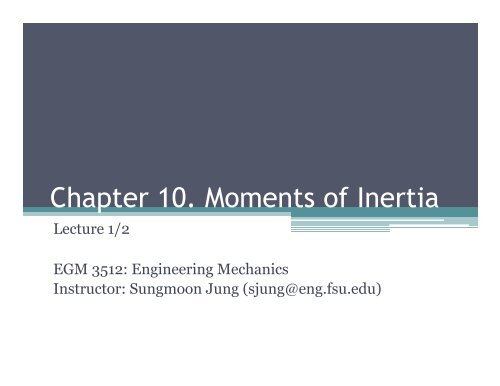Chapter 10. Moments of Inertia
Chapter 10. Moments of Inertia
Chapter 10. Moments of Inertia
Create successful ePaper yourself
Turn your PDF publications into a flip-book with our unique Google optimized e-Paper software.
What We Can Do After Learning This<strong>Chapter</strong>Image from:http://www.gtgrandstands.com/grandstand.htm• What are the moment <strong>of</strong> inertia <strong>of</strong> the I-beams?• What size <strong>of</strong> I-beams are safe to use in this building?(EGN 3331, Strength <strong>of</strong> Materials)
Example 1A• Compute the moment <strong>of</strong> the inertia about x-axis
Example 1B• Compute the moment <strong>of</strong> the inertia about y-axis
What We Need to Learn• Definition <strong>of</strong> the moment <strong>of</strong> inertia• Parallel axis theorem• To calculate the moment <strong>of</strong> inertia▫ Single area using integration▫ Composite areas using table• Mass moment <strong>of</strong> inertia
Motivation for Parallel-Axis Theorem• Given I x (or, after computing I x ), we<strong>of</strong>ten have to compute the moment <strong>of</strong>inertia for a new axis▫ Rather than new integration, atheorem would be useful• Many structural members arecomposed <strong>of</strong> simple shapes, in whichwe have “table” for computing them▫ A theorem would be useful, thatenables us to combine moments <strong>of</strong>inertia <strong>of</strong> all simple shapes
Parallel-Axis Theorem
Example 2• Compute moment <strong>of</strong> inertia about x’ axis, x b axis, and C.
Example 2 (Continued)• The above example illustrates how we can deriveequations for moments <strong>of</strong> inertia for simple shapes• If you go to the back <strong>of</strong> the textbook:• All other equations can be obtained similarly
Example 3• Compute I x
Example 3 (Alternative Approach)What if we take a vertical slice? (moment arm) 2 ×(area), but the moment arm changes over the heightMethod 1: double integral
Example 3 (Alternative App, Cont’d)Method 2: use table and the parallel axis theorem


